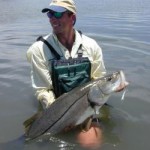Florida’s Poster-Child Fish
The uncommon Common SnookBy Frank Sargeant, Editor
from The Fishing Wire
Florida’s spring snook season is upon us, and odds are that after the winter closure, Sunshine State anglers are going to find a lot of dumb, happy snook eager to take their baits and lures.
Snook have a special attraction both for resident anglers and for visitors from all over the world. Someone aptly noted they behave like “largemouth bass on angel dust” when hooked–they truly go berserk, and many of them have awesome size to add to their unique speed and jumping ability–fish of 8 to 10 pounds are common, and 20 pounders are always a possibility.
Whether you decide to kill your legal fish-one per day between 28 and 33 inches on the west side of the state, one per day between 28 and 32 inches on the east side-or release it is between you and the conservation gods, but if you choose to release it, FFWCC biologists say there’s a great chance it will survive. In tests where captured snook were held for several days after being hooked, transported in a livewell and then released into a mesh pen, 98 percent survived long term.
Of course, that’s assuming the next angler to come along and hook it does not decide he’d rather have the fillets than a chance at catching a bigger fish later on.
Though tens of thousands of snook died in the 2010 freeze, the Fish & Wildlife Commission noted the species has staged a strong comeback in the intervening years, and determined there are now enough “spare” fish in the keeper slot to allow harvest.
Whether you agree or disagree with this-and some guides and expert anglers would just as soon see snook closed permanently, to become a catch-and-release species-if you want to tangle with snook this spring, a few basics will help you get hooked up.
First, though there are some straggler populations as far north as Crystal River on the West Coast, and up to Daytona Beach on the East Coast, the best fishing is a bit farther south on either side–roughly from Holmes Beach on the west side, and from Fort Pierce on the east.
On either shore, snook feed best when and where currents are strongest. While the strong flows around the new and full moons make good fishing most everywhere in the back country, the intermediate moon periods mean best fishing is limited to the deeper passes, sloughs, cuts, holes and mangrove points on peak tidal periods.
And of course those peak flows change progressively as you move from the beaches to far up in the black-water areas and tidal rivers. Learning to gauge the difference from the published tide tables to your chosen fishing area is key to catching snook.
If you are not an expert lure fisherman, forget artificials and invest in a cast net and a big live well. Live scaled sardines make these very smart fish stupid. Use the sardines both as live chum, pitching a few out to drift down deep shorelines and through cuts until one gets blasted, and as live bait, nose-hooked on short-shank 1/0 livebait hooks.
The season continues until May 1 on the West Coast, June 1 on the East Coast, then is closed until September 1 on both shores to allow the fish to spawn in relative peace. The spawn continues into September most years, and you’re likely to find concentrations of catch-and-release fish behind the first breakwater or the first side bay off major passes from the gulf, as well as from the larger bays. The spawn occurs around the new and full moons.
Most of the snook you catch in Florida these days will not be in the slot-it’s just 5 inches wide on the west side, 4 inches on the east side. So use single hook rigs or lures and have a dehooker at hand, ready to get the barbs out quickly and get the fish back over the side after a quick photo; that way, we can be sure the return of the snook population continues, and hopefully there won’t be another extended closure any time soon.
